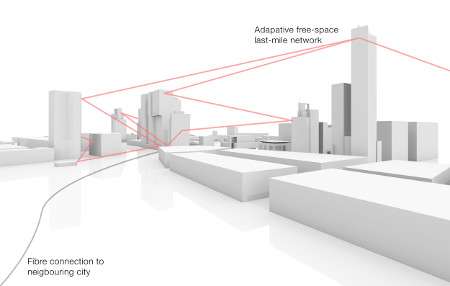26 Oct 2017
Scientists have taken an important step towards using ‘twisted’ light as a form of wireless, high-capacity data transmission which could make fibre-optics obsolete.
In a new report published today (Thursday 26 October) in the journal Science Advances, a team of physicists based in the UK, Germany, New Zealand and Canada describe how new research into ‘optical angular momentum’ (OAM) could overcome current difficulties with using twisted light across open spaces.
Scientists can ‘twist’ photons – individual particles of light – by passing them through a special type of hologram, similar to that on a credit card, giving the photons a twist known as optical angular momentum.
While conventional digital communications use photons as ones and zeroes to carry information, the number of intertwined twists in the photons allows them to carry additional data – something akin to adding letters alongside the ones and zeroes. The ability of twisted photons to carry additional information means that optical angular momentum has the potential to create much higher-bandwidth communications technology.
While optical angular momentum techniques have already been used to transmit data across cables, transmitting twisted light across open spaces has been significantly more challenging for scientists to date. Even simple changes in atmospheric pressures across open spaces can scatter light beams and cause the spin information to be lost.
The researchers examined the effects on both the phase and intensity of OAM carrying light over a real link in an urban environment to assess the viability of these modes of quantum information transfer.
Their free space link, in Erlangen, Germany, was 1.6km in length and passed over fields and streets and close to high-rise buildings to accurately simulate an urban environment and atmospheric turbulence that can disrupt information transfer in space – a thorough approach that will be instrumental in moving OAM research forward.
Conducting this field tests in a real urban environment, has revealed exciting new challenges that will that must be overcome before systems can be made commercially available. Previous studies had indicated the potential feasibly of OAM communication systems, but had not fully characterised the effects of turbulent air on the phase of the structured light propagating over links of this length.
Dr. Martin Lavery, head of the Structured Photonics Research Group at University of Glasgow, is the lead author on the team’s research paper. Dr Lavery said: “In an age where our global data consumption is growing at an exponential rate, there is mounting pressure to discover new methods of information carrying that can keep up with the huge uptake in data across the world.
“A complete, working optical angular momentum communications system capable of transmitting data wirelessly across free space has the potential to transform online access for developing countries, defence systems and cities around the world.
“Free space optics is a solution that can potentially give us the bandwidth of fibre, but without the requirement for physical cabling.
“This study takes vital steps forward in the journey towards high dimensional free space optics that can be a cheaper, more accessible alternative to buried fibre optics connections.”
The turbulent atmosphere used in this experiment highlighted the fragility of shaped phase fronts, particularly for those that would be integral to high-bandwidth data transfers. This study indicated the challenges future adaptive optical systems will be required to resolve.
Dr. Lavery added: “With these new developments, we are confident that we can now re-think our approaches to channel modelling and the requirement places on adaptive optics systems. We are getting ever closer to developing OAM communications that can be deployed in a real urban setting.
“We want to start a conversation about the issues that need to be addressed and how we are going to move towards the resolution.”
Dr Lavery undertook the work in partnership with researchers from the Max Planck Institute for the Science of Light and Institute of Optics, and the Universities of Otago, Ottawa and Rochester.
These findings allow researchers to address challenges – not previously observed – in developing adaptive optics for quantum information transfer to move closer towards a new age of free space optics that will eventually replace fibre optics as a functional mode of communication in urban environments and remote sensing systems.
The paper, titled ‘Free-space propagation of high dimensional structured optical fields in an urban environment’, is published in Science Advances. The work was funded by Royal Academy of Engineering, EPSRC and supported by the International Max Planck Partnership.















